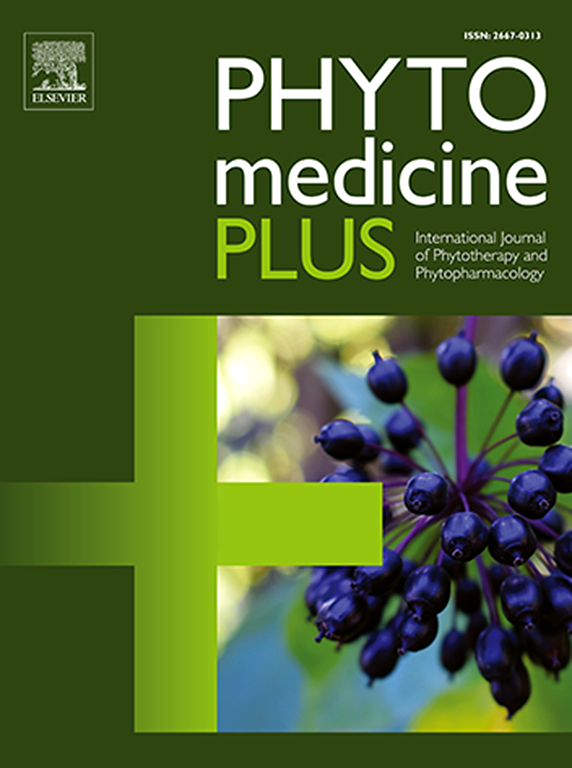bolusiana Schinz和iomoea crassipes Hook块茎的体外和体内抗糖尿病潜能、葡萄糖代谢、抗氧化、细胞毒性和植物化学成分的评价
Q3 Pharmacology, Toxicology and Pharmaceutics
引用次数: 0
摘要
糖尿病是一种慢性代谢性疾病,由遗传疾病和其他因素引起,如某些药物的使用、胰腺损伤和自身免疫性疾病,如类风湿关节炎和高血压。然而,目前有几种治疗药物用于控制血糖水平,从而降低并发症的风险。尽管努力治疗或控制这种疾病,但目前的治疗药物具有有害的副作用,因此需要开发副作用更少的新型有效药物。本研究旨在评价bolusiana和crassia植物提取物对α-淀粉酶的抑制能力和抗氧化能力。在RAW 264.7巨噬细胞、C3A肝细胞和L6成肌细胞中对提取物的细胞毒性和糖代谢进行了评价。方法采用α-淀粉酶抑制法测定其体外抗糖尿病活性,并评价其抗氧化活性。此外,采用2,2-二苯基-1-苦基肼(DPPH)、2,2 ' -氮基-双(3-乙基苯并噻唑啉-6-磺酸(ABTS))自由基清除法和超氧化物歧化酶(SOD)酶清除法考察了它们对自由基的抑制能力。采用3-(4,5-二甲基噻唑-2-基)-2,5-二苯基溴化四唑(MTT)比色法测定巨噬细胞(RAW 264.7)、肝细胞(C3A)和成肌细胞(L6)细胞的细胞毒性和葡萄糖代谢。此外,利用FTIR、1HNMR和UHPLCOrbitrap HRMS、FTIR进行了植物化学表征和初步鉴定,同时利用计算研究确定了提取物与α-淀粉酶的生化相互作用、抗糖尿病和抑制潜力。结果青花和花楸提取物对α-淀粉酶的抑制率在10.72 ~ 30.08%之间,表现出中等水平的抑制活性。提取物对处理过的细胞没有细胞毒性作用。bolusiana和I. crassia提取物显著增加了L6和C3A细胞株的葡萄糖摄取。其IC50值为7.35±0.43 ~ 12.02±0.21µg/mL。然而,提取物对细胞的毒性较小,因为它们显示出IC50值>;20µg / mL。植物化学评价表明,与α-淀粉酶对接的提取物中存在酚类物质、绿原酸、香豆素糖苷和黄酮类物质。5-咖啡酰奎宁酸的结合能最高,为-6.829 kcal/mol。结论该研究表明,金盏花和金盏花甲醇提取物具有多种重要的植物成分和广谱活性,包括α-淀粉酶抑制活性、降低氧化应激、降低毒性和增加葡萄糖代谢,是抗糖尿病活性分子的有希望的分离来源。本研究记录的结果将为糖尿病和氧化应激治疗候选药物的开发提供有价值的线索。本文章由计算机程序翻译,如有差异,请以英文原文为准。

Evaluation of in-vitro and in-silico antidiabetic potential, glucose metabolism, antioxidant, cytotoxicity and phytochemical content of Ipomoea bolusiana Schinz and Ipomoea crassipes Hook tubers
Background
Diabetes Mellitus is a chronic metabolic disorder caused by genetic disorders and other factors such as the use of certain medications, pancreatic injury, and autoimmune diseases such as rheumatoid arthritis and high blood pressure. However, several therapeutic agents are currently used to manage blood sugar levels, thus reducing the risk of complications. Despite efforts to treat or manage this disease, current therapeutic agents have detrimental side effects, presenting a considerable need to develop new effective drugs with fewer adverse effects.
The aim of the study
This study aimed to evaluate the inhibitory capacity of I. bolusiana and I. crassipe plant extracts on α-amylase enzyme and to assess the antioxidant capacity. Furthermore, the evaluation of the cytotoxicity properties and glucose metabolism of the extracts was carried out in RAW 264.7 macrophages, C3A hepatocytes and L6 myoblast cell lines.
Methods
In vitro antidiabetic activity was tested with α-amylase enzyme inhibition method and antioxidant activity was evaluated. Furthermore, their ability to quench free radicals was investigated using the 2,2-diphenyl-1-picryhydrazyl (DPPH), 2,2′-azino-bis(3-ethylbenzothiazoline-6-sulfonic acid (ABTS) free radical scavenging method and the superoxide dismutase (SOD) enzyme scavenging method was investigated. Cytotoxicity and glucose metabolism were measured in macrophage (RAW 264.7), hepatocytes (C3A) and myoblast (L6) cells using the colorimetric test 3- (4,5-dimethylthiazol-2-yl) -2,5-diphenyltetrazolium bromide (MTT). Furthermore, phytochemical characterization and tentative identification was performed using FTIR, 1H![]() NMR and UHPLC
NMR and UHPLC![]() Orbitrap HRMS, FTIR, whilst computational studies were also employed to determine the biochemical interaction, antidiabetic and inhibitory potential of the extracts with the α-amylase enzyme.
Orbitrap HRMS, FTIR, whilst computational studies were also employed to determine the biochemical interaction, antidiabetic and inhibitory potential of the extracts with the α-amylase enzyme.
Results
The extracts of I. bolusiana and I. crassipes exhibited moderate inhibitory activity against α-amylase with an inhibitory percentage range of 10.72 – 30.08 %. The extracts did not show cytotoxic effects in the treated cells. The extracts of I. bolusiana and I. crassipes significantly increased glucose uptake in L6 and C3A cell lines. The extracts reduced the DPPH and ABTS radicals, showing a range of IC50 values of 7.35 ± 0.43 - 12.02 ± 0.21 µg/mL. However, the extracts were less toxic to the cells as they showed IC50 values > 20 µg/mL. The phytochemical evaluation demonstrated the presence of phenolics, chlorogenic acids, coumarin glucosides and flavonoids in the extracts, which were docked with the α-amylase enzyme. 5-caffeoylquinic acid exhibited the highest binding energy of -6.829 kcal/mol.
Conclusions
This study presents various important phytoconstituents and broad-spectrum activities, including α-amylase inhibitory activity, reduction of oxidative stress, less toxicity, and increased glucose metabolism of methanol extracts of I. bolusiana and I. crassipes as a promising source for the isolation of molecules responsible for antidiabetes activities. The results documented in this study will be valuable leads in the development of therapeutic candidates for diabetes and oxidative stress.
求助全文
通过发布文献求助,成功后即可免费获取论文全文。
去求助
来源期刊

Phytomedicine Plus
Medicine-Complementary and Alternative Medicine
CiteScore
3.70
自引率
0.00%
发文量
178
审稿时长
81 days
期刊介绍:
 求助内容:
求助内容: 应助结果提醒方式:
应助结果提醒方式:


